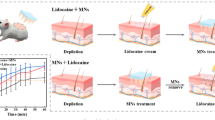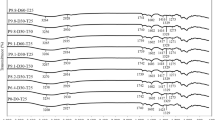Abstract
Acute postoperative pain is commonly treated with flurbiprofen (FBP), but conventional delivery methods are suboptimal. This study prepared a new non-burst release microneedles (MNs) using genipin cross-linked gelatin (cGel). By adding varying amounts of genipin to modulate the crosslinking degree of cGel, the drug release behavior of the drug-loaded MNs in the skin can be altered. The crosslinking parameters that meet therapeutic requirements are selected, thus providing rapid and long-lasting analgesic effects. cGel solutions were successfully cross-linked, altering matrix material microstructure, confirmed by scanning electron microscope imaging and fourier transform infrared spectroscopy. MNs demonstrated increasing mechanical strength with higher crosslinking. Drug release rates were rapid initially, then slowed, exhibiting a characteristic of decreased release rates with increasing degrees of crosslinking. In vivo, FBP/cGel MNs significantly reduced allodynia and hyperalgesia post-surgery, with the greatest effect observed at 2–3 h post-surgery, and can maintain analgesia for up to 6 h. Biosafety tests confirmed good biocompatibility. FBP/cGel MNs effectively penetrate the stratum corneum, safely delivering drugs with significant analgesic effects, excellent mechanical properties, and good biocompatibility, representing a promising strategy for managing acute postoperative pain.

Similar content being viewed by others
References
Taylor, R. S.; Ullrich, K.; Regan, S.; Broussard, C.; Schwenkglenks, M.; Taylor, R. J.; Gordon, D. B.; Zaslansky, R.; Meissner, W.; Rothaug, J. et al. The impact of early postoperative pain on healthrelated quality of life. Pain Pract. 2013, 13, 515–523.
Mitra, S.; Carlyle, D.; Kodumudi, G.; Kodumudi, V.; Vadivelu, N. New advances in acute postoperative pain management. Curr. Pain Headache Rep. 2018, 22, 35.
Benyamin, R.; Trescot, A. M.; Datta, S.; Buenaventura, R.; Adlaka, R.; Sehgal, N.; Glaser, S. E.; Vallejo, R. Opioid complications and side effects. Pain Physician 2008, 11, S105–S120.
Joshi, G. P.; Kehlet, H. Postoperative pain management in the era of ERAS: An overview. Best Pract. Res. Clin. Anaesthesiol. 2019, 33, 259–267.
O’Neill, A.; Lirk, P. Multimodal analgesia. Anesthesiol. Clin. 2022, 40, 455–468.
Schug, S. A.; Manopas, A. Update on the role of non-opioids for postoperative pain treatment. Best Pract. Res. Clin. Anaesthesiol. 2007, 21, 15–30.
Gustafsson, U. O.; Scott, M. J.; Hubner, M.; Nygren, J.; Demartines, N.; Francis, N.; Rockall, T. A.; Young-Fadok, T. M.; Hill, A. G.; Soop, M. et al. Guidelines for perioperative care in elective colorectal surgery: Enhanced Recovery After Surgery (ERAS®) Society recommendations: 2018. World J. Surg. 2019, 43, 659–695.
Cashman, J. N. The mechanisms of action of NSAIDs in analgesia. Drugs 1996, 52, 13–23.
Gupta, A.; Bah, M. NSAIDs in the treatment of postoperative pain. Curr. Pain Headache Rep. 2016, 20, 62.
Nathi, R.; Ketha, N. V. D. P.; Kowtarapu, L. P.; Muchakayala, S. K.; Konduru, N.; Saroja, B.; Marisetti, A. L. Flurbiprofen cataplasms: Development and validation of in-vitro dissolution methods and evaluation of multimedia dissolution profiles. Pharm. Sci. Adv. 2023, 1, 100018.
Shah, K.; Gupta, J. K.; Chauhan, N. S.; Upmanyu, N.; Shrivastava, S. K.; Mishra, P. Prodrugs of NSAIDs: A review. Open Med. Chem. J. 2017, 11, 146–195.
Nir, Y.; Paz, A.; Sabo, E.; Potasman, I. Fear of injections in young adults: Prevalence and associations. Am. J. Trop. Med. Hyg. 2003, 68, 341–344.
Usach, I.; Martinez, R.; Festini, T.; Peris, J. E. Subcutaneous injection of drugs: Literature review of factors influencing pain sensation at the injection site. Adv. Ther. 2019, 36, 2986–2996.
Prausnitz, M. R.; Langer, R. Transdermal drug delivery. Nat. Biotechnol. 2008, 26, 1261–1268.
Jiang, J. Z.; Ma, T. Y.; Zhang, L. H.; Cheng, X. M.; Wang, C. H. The transdermal performance, pharmacokinetics, and antiinflammatory pharmacodynamics evaluation of harmine-loaded ethosomes. Drug Dev. Ind. Pharm. 2020, 46, 101–108.
Yu, Y. Q.; Yang, X.; Wu, X. F.; Fan, Y. B. Enhancing permeation of drug molecules across the skin via delivery in nanocarriers: Novel strategies for effective transdermal applications. Front. Bioeng. Biotechnol. 2021, 9, 646554.
An, H.; Gu, Z.; Huang, Z.; Huo, T.; Xu, Y. X.; Dong, Y. Z.; Wen, Y. Q. Novel microneedle platforms for the treatment of wounds by drug delivery: A review. Colloids Surf. B Biointerfaces 2024, 233, 113636.
Zheng, M. J.; Sheng, T.; Yu, J. C.; Gu, Z.; Xu, C. J. Microneedle biomedical devices. Nat. Rev. Bioeng. 2024, 2, 324–342.
Nordquist, L.; Roxhed, N.; Griss, P.; Stemme, G. Novel microneedle patches for active insulin delivery are efficient in maintaining glycaemic control: An initial comparison with subcutaneous administration. Pharm. Res. 2007, 24, 1381–1388.
Van Der Maaden, K.; Jiskoot, W.; Bouwstra, J. Microneedle technologies for (trans) dermal drug and vaccine delivery. J. Controlled Release 2012, 161, 645–655.
Omatsu, T.; Chujo, K.; Miyamoto, K.; Okida, M.; Nakamura, K.; Aoki, N.; Morita, R. Metal microneedle fabrication using twisted light with spin. Opt. Express 2010, 18, 17967–17973.
Chen, B. T.; Wei, J. S.; Tay, F. E. H.; Wong, Y. T.; Iliescu, C. Silicon microneedle array with biodegradable tips for transdermal drug delivery. Microsyst. Technol. 2008, 14, 1015–1019.
Ita, K. Ceramic microneedles and hollow microneedles for transdermal drug delivery: Two decades of research. J. Drug Deliv. Sci. Technol. 2018, 44, 314–322.
Han, J. P.; Sheng, T.; Zhang, Y. Q.; Cheng, H.; Gao, J. Q.; Yu, J. C.; Gu, Z. Bioresponsive immunotherapeutic materials. Adv. Mater., in press, https://doi.org/10.1002/adma.202209778.
Yang, Y.; Chu, H. Q.; Zhang, Y.; Xu, L. L.; Luo, R. Z.; Zheng, H.; Yin, T. L.; Li, Z. Rapidly separable bubble microneedle patch for effective local anesthesia. Nano Res. 2022, 15, 8336–8344.
Luo, F. Q.; Chen, G. J.; Xu, W.; Zhou, D. J.; Li, J. X.; Huang, Y. C.; Lin, R.; Gu, Z.; Du, J. Z. Microneedle-array patch with pH-sensitive formulation for glucose-responsive insulin delivery. Nano Res. 2021, 14, 2689–2696.
Hong, T.; Shen, X. Y.; Syeda, M. Z.; Zhang, Y.; Sheng, H. N.; Zhou, Y. P.; Xu, J. M.; Zhu, C. J.; Li, H. J.; Gu, Z. et al. Recent advances of bioresponsive polymeric nanomedicine for cancer therapy. Nano Res. 2023, 16, 2660–2671.
Su, K.; Wang, C. M. Recent advances in the use of gelatin in biomedical research. Biotechnol. Lett. 2015, 37, 2139–2145.
Echave, M. C.; Hernáez-Moya, R.; Iturriaga, L.; Pedraz, J. L.; Lakshminarayanan, R.; Dolatshahi-Pirouz, A.; Taebnia, N.; Orive, G. Recent advances in gelatin-based therapeutics. Expert Opin. Biol. Ther. 2019, 19, 773–779.
Liang, H. C.; Chang, W. H.; Liang, H. F.; Lee, M. H.; Sung, H. W. Crosslinking structures of gelatin hydrogels crosslinked with genipin or a water-soluble carbodiimide. J. Appl. Polym. Sci. 2004, 91, 4017–4026.
Bozzini, S.; Petrini, P.; Altomare, L.; Tanzi, M. C. Fabrication of chemically cross-linked porous gelatin matrices. J. Appl. Biomater. Biomech. 2009, 7, 194–199.
Vijayakumar, V.; Subramanian, K. Diisocyanate mediated polyether modified gelatin drug carrier for controlled release. Saudi Pharm. J. 2014, 22, 43–51.
Ahmed, R.; Ul Ain Hira, 5N.; Wang, M. W.; Iqbal, S.; Yi, J.; Hemar, Y. Genipin, a natural blue colorant precursor: Source, extraction, properties, and applications. Food Chem. 2024, 434, 137498.
Kirchmajer, D. M.; Watson, C. A.; Ranson, M.; Panhuis, M. I. H. Gelapin, a degradable genipin cross-linked gelatin hydrogel. RSC Adv. 2013, 3, 1073–1081.
Butler, M. F.; Ng, Y. F.; Pudney, P. D. A. Mechanism and kinetics of the crosslinking reaction between biopolymers containing primary amine groups and genipin. J. Polym. Sci. A Pol. Chem. 2003, 41, 3941–3953.
Bigi, A.; Panzavolta, S.; Roveri, N. Hydroxyapatite-gelatin films: A structural and mechanical characterization. Biomaterials 1998, 19, 739–744.
Ohri, R.; Wang, J. C. F.; Blaskovich, P. D.; Pham, L. N.; Costa, D. S.; Nichols, G. A.; Hildebrand, W. P.; Scarborough, N. L.; Herman, C. J.; Strichartz, G. R. Inhibition by local bupivacaine-releasing microspheres of acute postoperative pain from hairy skin incision. Anesth. Analg. 2013, 117, 717–730.
Van De Loosdrecht, A. A.; Nennie, E.; Ossenkoppele, G. J.; Beelen, R. H. J.; Langenhuijsen, M. M. A. C. Cell mediated cytotoxicity against U 937 cells by human monocytes and macrophages in a modified colorimetric MTT assay: A methodological study. J. Immunol. Methods 1991, 141, 15–22.
Zhen, Z.; Liu, X. L.; Huang, T.; **, T. F.; Zheng, Y. F. Hemolysis and cytotoxicity mechanisms of biodegradable magnesium and its alloys. Mater. Sci. Eng. C 2015, 46, 202–206.
Chen, B. Z.; Zhang, L. Q.; **a, Y. Y.; Zhang, X. P.; Guo, X. D. A basal-bolus insulin regimen integrated microneedle patch for intraday postprandial glucose control. Sci. Adv. 2020, 6, eaba7260.
Friedman, M. Applications of the ninhydrin reaction for analysis of amino acids, peptides, and proteins to agricultural and biomedical sciences. J. Agric. Food Chem. 2004, 52, 385–406.
Wang, Q. L.; Zhu, D. D.; Chen, Y.; Guo, X. D. A fabrication method of microneedle molds with controlled microstructures. Mater. Sci. Eng. C 2016, 65, 135–142.
Duarte, A. M.; Pospisilova, E.; Reilly, E.; Mujenda, F.; Hamaya, Y.; Strichartz, G. R. Reduction of postincisional allodynia by subcutaneous bupivacaine: Findings with a new model in the hairy skin of the rat. Anesthesiology 2005, 103, 113–125.
Podgórski, R.; Wojasiński, M.; Ciach, T. Nanofibrous materials affect the reaction of cytotoxicity assays. Sci. Rep. 2022, 12, 9047.
Acknowledgements
This research was funded by the National Key Research and Development Program of China (Nos. 2022YFB3205602 and 2022YFB3804703), the National Natural Science Foundation of China (Nos. 52372174, 61875015, and T2125003), the Bei**g Natural Science Foundation (Nos. L212046 and L212010), the Fundamental Research Funds for the Central Universities. All animal experiments conducted in this study were reviewed and approved by the Animal Experimentation Ethics Committee of the Cancer Hospital, Chinese Academy of Medical Sciences (Ethical Approval No. NCC2023A291).
Author information
Authors and Affiliations
Corresponding authors
Electronic Supplementary Material
Rights and permissions
About this article
Cite this article
Chu, H., Zhang, Y., Yang, Y. et al. Flurbiprofen microneedle patches for the management of acute postoperative pain. Nano Res. (2024). https://doi.org/10.1007/s12274-024-6751-x
Received:
Revised:
Accepted:
Published:
DOI: https://doi.org/10.1007/s12274-024-6751-x




